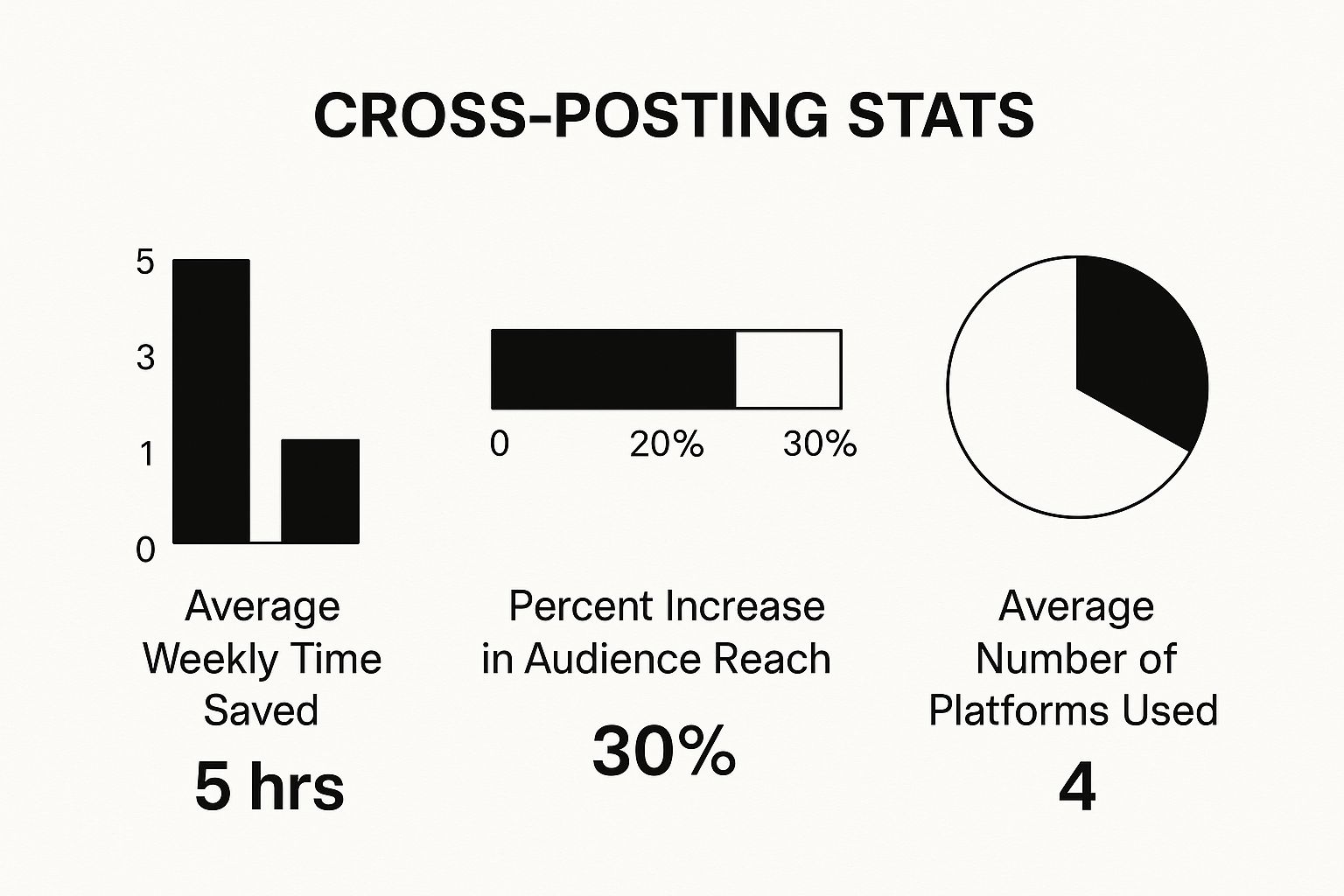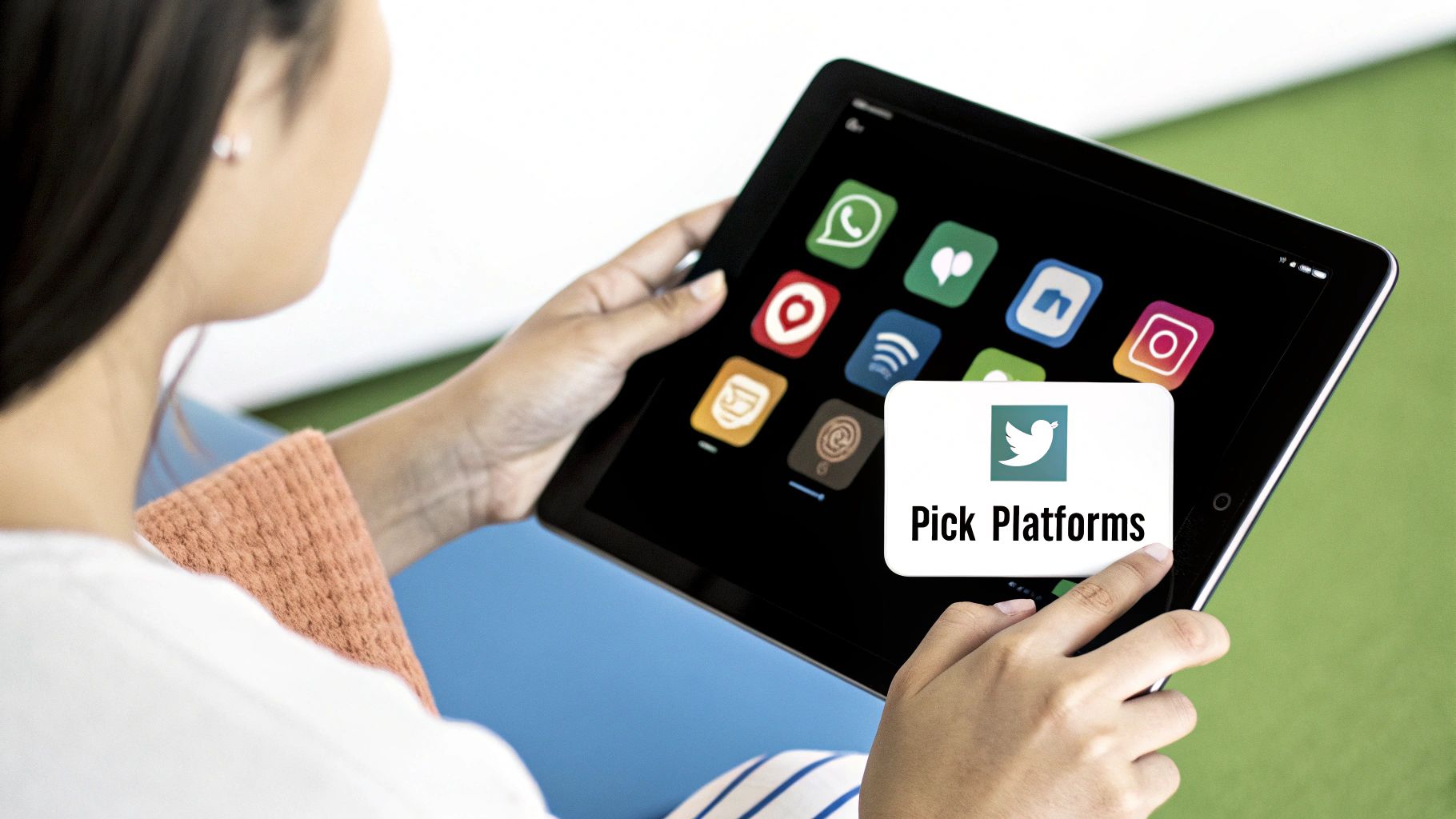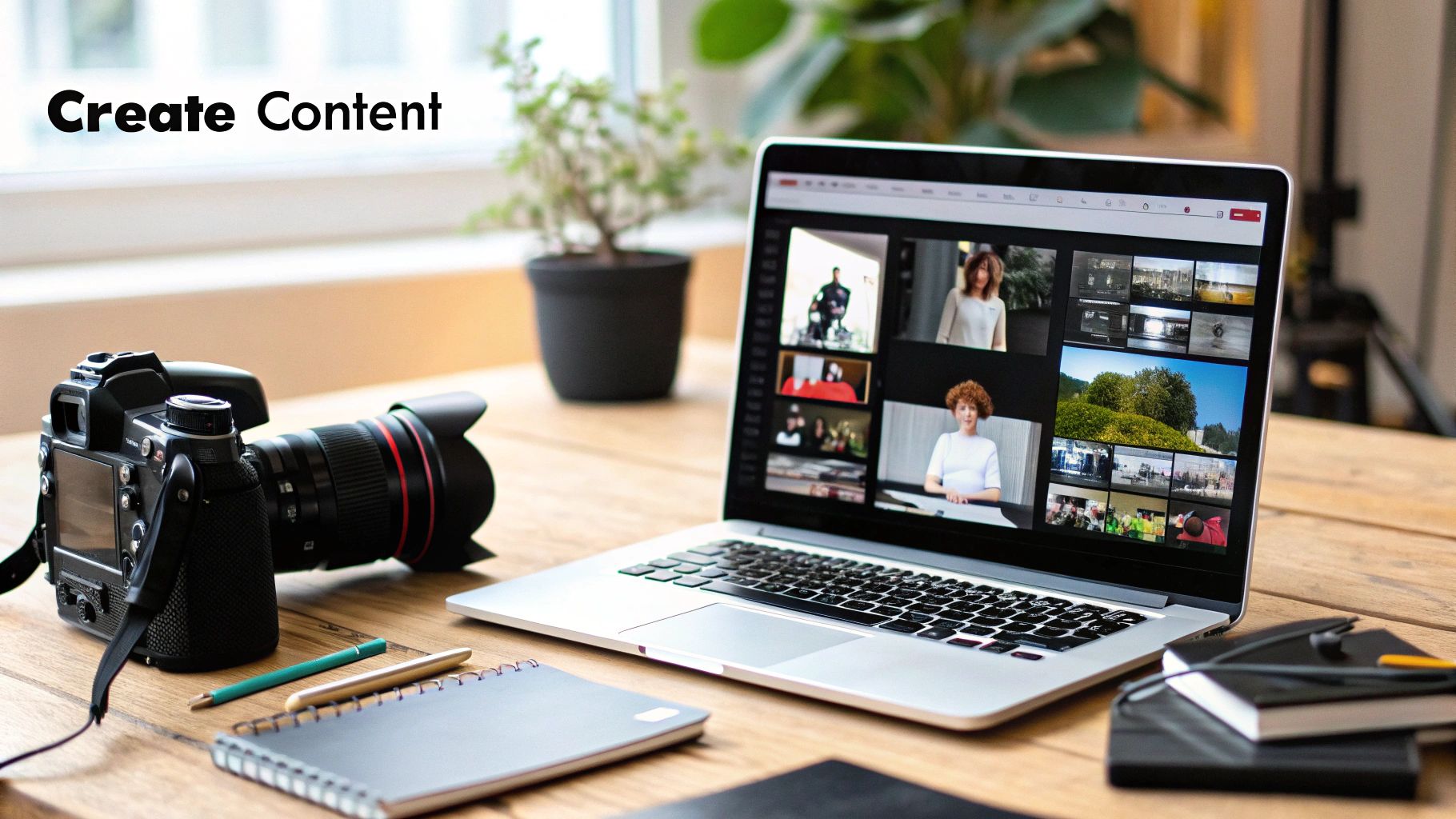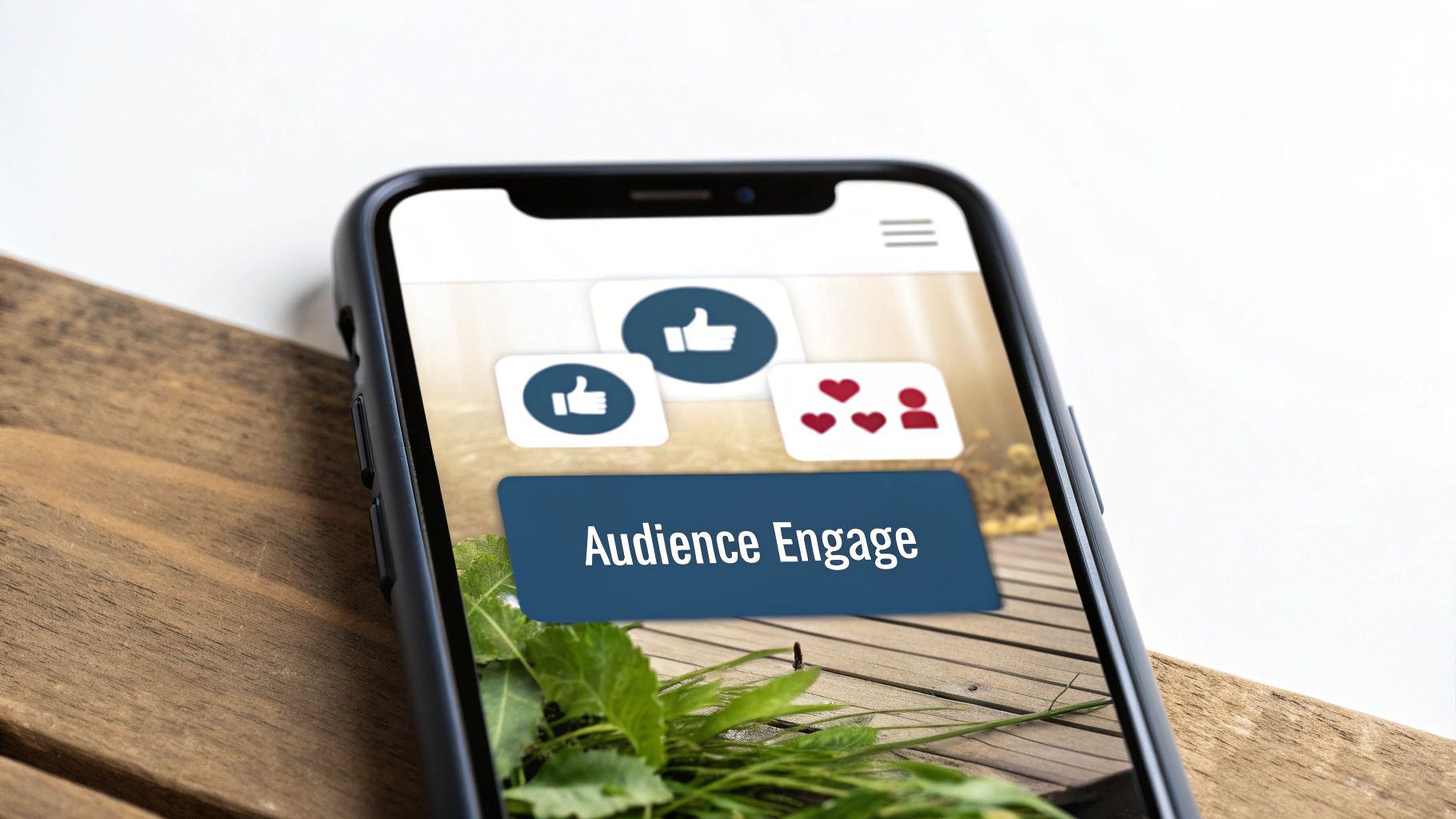If you've ever tried to manually post across multiple social media platforms, you know the feeling. It's a surefire path to burnout, and worse, it's a graveyard of missed opportunities. For any brand that's serious about growth, this juggling act just isn't sustainable. It leads to sloppy messaging, posting at the wrong times, and completely stalling your ability to scale.
Why Manual Social Media Posting Is a Losing Game
Let's be real: keeping up with just one social media account is a job in itself. Now, try to build a real presence on Facebook, Instagram, LinkedIn, and X (formerly Twitter). The task quickly becomes overwhelming when you're doing it all by hand. The most obvious cost is your time, but the strategic damage is what really hurts.
I've seen it countless times. Think of a small business owner—let’s call her Sarah—who runs an online boutique. Every day, she's sinking hours into manually creating and uploading content. She posts a product shot on Instagram, rewrites the caption for her Facebook Page, and then tries to spin it into a professional announcement for LinkedIn.
While she’s bogged down in this cycle of uploading, she's missing the peak engagement windows when her followers are actually online. Her brand voice feels a little different on each platform because she's rushing, and her ability to jump on comments and messages takes a backseat. That genuine community building, the very heart of social media, becomes an afterthought.
The Hidden Costs of the Manual Grind
This hands-on approach doesn't just drain your energy; it actively stunts your growth. The problems run much deeper than just not having enough hours in the day:
- Fragmented Branding: When you create posts on the fly for each network, you end up with slight (or major) inconsistencies in your tone, style, and messaging. This slowly erodes a cohesive brand identity.
- Wasted Opportunities: The best time to post on Instagram is rarely the same as on LinkedIn. Without automation, you simply can't be there to hit every platform's sweet spot, every time.
- No Room to Grow: As your brand gains traction, the demand for content skyrockets. Manual posting hits a hard ceiling, and it can't keep up with what an expanding audience expects.
This isn't just a feeling; the data backs it up. The move away from manual work to a more streamlined process has tangible benefits.

The numbers make it clear: automation gives you back a massive amount of time while multiplying your reach across an average of four different platforms.
Manual Posting vs. API Automation
To put it in perspective, here’s a look at how the daily reality changes when you shift from manual work to an API-driven strategy.
| Activity | Manual Posting Approach | API-Driven Automation |
|---|---|---|
| Daily Workflow | Log in/out of each platform. Copy, paste, and reformat content repeatedly. | Set up one post, schedule it once, and the API handles distribution to all platforms. |
| Timing | Post only when you are physically available, often missing peak user times. | Schedule posts for optimal engagement windows on each specific platform, 24/7. |
| Consistency | Brand voice and visuals can vary due to rush and human error. | A single source of truth ensures consistent branding and messaging everywhere. |
| Scalability | Adding a new platform means exponentially more daily work. | Adding a new platform is a simple one-time connection. |
| Focus | 80% of time spent on the repetitive task of posting. | 80% of time freed up for strategy, analytics, and community interaction. |
The difference is stark. One approach keeps you stuck in a reactive loop, while the other empowers you to be proactive and strategic.
Embracing a Smarter, Automated Strategy
Today's social media world is incredibly fragmented. We're talking about over 5.24 billion active users globally, with the average person hopping between nearly seven different platforms a month. You can dig into the latest numbers on Backlinko.com. Trying to reach that massive, diverse audience by hand is an uphill battle you are set up to lose.
Automation isn't about getting rid of the human touch. It's about earning back the time you need to actually be human. When you automate the tedious task of posting, you unlock hours for what really drives growth—analyzing performance, refining your strategy, and having authentic conversations with your community.
At the end of the day, to effectively post on multiple social media channels, automation has shifted from a "nice-to-have" to a core necessity for staying competitive and achieving sustainable growth.
Getting Started with the LATE API

Jumping into a new API can feel like deciphering a cryptic puzzle. But getting the LATE API up and running is refreshingly simple. We designed it for developers who just need to get things working, and working reliably. This isn't just about reading docs; it's about getting you to that first successful API call, fast.
Your first step is to grab your API keys. Think of these as your personal passport into the LATE ecosystem. You'll find them waiting for you in your dashboard right after you sign up.
A quick but critical piece of advice: treat these keys like you would any sensitive credentials. Store them securely in environment variables, never hardcoded into your application. Honestly, this is the number one mistake we see developers make, and it’s a painful one to fix later.
With your keys safely stored, you're ready for authentication. LATE uses the industry-standard OAuth 2.0 flow, which is a secure, user-approved way to connect to each social media account. This part is non-negotiable for any app that plans to post on multiple social media platforms on a user's behalf.
Your First API Call with Python
Let's make this real. Here’s a quick Python snippet to show you how to get your environment set up and make a test call. We're using the popular requests library here.
import os
import requests
Best practice: Load your credentials from environment variables
API_KEY = os.environ.get("LATE_API_KEY")
API_SECRET = os.environ.get("LATE_API_SECRET")
The base URL for all LATE API endpoints
BASE_URL = "https://api.getlate.dev/v1"
def check_api_status():
"""A simple function to verify your connection to the LATE API."""
try:
response = requests.get(f"{BASE_URL}/status", headers={"X-API-KEY": API_KEY})
response.raise_for_status() # Raises an exception for bad status codes (4xx or 5xx)
print("Successfully connected to the LATE API!")
print(response.json())
except requests.exceptions.HTTPError as err:
print(f"HTTP Error: {err}")
except Exception as e:
print(f"An error occurred: {e}")
Run the check
check_api_status()
This script doesn't actually post anything yet—its only job is to confirm that your API key is valid and you have a clear line of communication to our servers. Once you get a successful response, you're good to go.
Choosing the Right Permissions
When you kick off the OAuth flow, you have to ask for specific permissions, or "scopes." It can be tempting to request access to everything right away, but this is often a red flag for users. A much better strategy is to ask only for the permissions your app absolutely needs to function.
Here's how that might look:
- For scheduling posts: You'll need
posts.write. - For reading analytics: You'll request
analytics.read. - For managing comments: You would ask for
comments.manage.
My advice? Start with the absolute minimum scopes required. As you build out new features, you can always ask users for additional permissions later. This approach builds trust from day one and usually results in much higher connection rates.
Nailing these fundamentals is the key to building a solid, reliable integration. While this gets your foot in the door, you can gain even more granular control by exploring the nuances of each platform. For a deeper dive, check out our complete guide on the unified social media API, where we break down platform-specific quirks and more advanced connection strategies.
By following these initial steps, you've already built a strong foundation for automating your entire social media workflow.
Connecting Your Social Media Accounts Securely

Alright, you've got your API keys. Now for the fun part: actually linking the social media platforms. This is where your application starts to feel real—where it goes from just code to a tool that can post on multiple social media channels.
But here's a word of caution: every social network plays by its own rules. You can't just apply a one-size-fits-all approach. Understanding these platform-specific quirks is the difference between a smooth integration and a support ticket nightmare.
For example, connecting a Facebook Page is a completely different beast than linking a personal profile or an Instagram Business account. The API demands specific permissions for every single action, and it's on you to request only what you absolutely need. This isn't just a technical hoop to jump through; it's about building trust. When someone grants your app access, they’re trusting you to be responsible and transparent.
Navigating Platform-Specific Rules
Let's break down the landscape. Each platform has a distinct API and its own permission structure. What works seamlessly for X (formerly Twitter) will likely throw an error on LinkedIn.
Facebook & Instagram: Meta's ecosystem is incredibly powerful, but it has firm boundaries. You'll almost exclusively be working with Facebook Pages and Instagram Business accounts. Why? To protect user privacy, Meta heavily restricts third-party API posting to personal Facebook profiles.
X (formerly Twitter): X has always been more developer-friendly. Once you get the user's consent through OAuth, posting and engaging is pretty straightforward.
LinkedIn: The name of the game here is professional content. The API lets you post to both personal profiles and Company Pages, but be prepared for a more rigorous app approval process. LinkedIn wants to ensure all content on its platform remains high-quality.
The trick is to tailor your connection flow for each platform. Anticipating these requirements from the get-go will save you—and your users—a ton of headaches.
A critical distinction to make early on is between a Facebook Page and a personal profile. I've seen so many developers stumble here. The Graph API is designed for business applications, so your integration must guide users to connect their official Pages, not their personal timelines.
This focus makes sense when you consider the scale. In 2025, Facebook is still the world's largest social network, with an eye-watering 3.07 billion monthly active users. This massive audience is exactly why developers need to post on multiple social media platforms, especially since content so often crosses between Meta's properties like Facebook, Instagram, and WhatsApp. You can learn more about these social media trends and what they mean for developers.
Managing Account Tokens Securely
When a user successfully connects an account, the platform gives you an access token. Think of this token as a digital key that authorizes your app to post for them. As you can imagine, managing a growing collection of these keys from different users across multiple platforms requires a rock-solid, secure storage strategy.
Simply chucking these tokens into a database table isn't enough. You have to encrypt them. A plain-text token is a glaring security hole just waiting to be exploited.
Here’s a basic conceptual example in Python that shows how you might handle this. It demonstrates how to link tokens to specific users and encrypt them before they ever touch your database—a non-negotiable best practice.
from cryptography.fernet import Fernet
In a real app, this key would be stored securely (e.g., in environment variables)
ENCRYPTION_KEY = b'your-super-secret-encryption-key'
cipher_suite = Fernet(ENCRYPTION_KEY)
def store_token(user_id, platform, access_token):
# Encrypt the token before it's stored
encrypted_token = cipher_suite.encrypt(access_token.encode('utf-8'))
# Now, you would save this encrypted token to your database
print(f"Storing encrypted token for user {user_id} on {platform}.")
# db.save(user_id, platform, encrypted_token)
def retrieve_token(user_id, platform):
# Fetch the encrypted token from your database
# encrypted_token = db.get(user_id, platform)
# For this example, we'll use a placeholder
encrypted_token_placeholder = b'gAAAAAB...'
decrypted_token = cipher_suite.decrypt(encrypted_token_placeholder).decode('utf-8')
return decrypted_token
Example Usage
store_token(101, "linkedin", "linkedin_user_access_token_abc123")
With this approach, even if your database were somehow compromised, the user tokens would remain unreadable gibberish. Building your system with security baked in from the very beginning isn't just a good idea; it's the only way to build a trustworthy application.
Crafting Your First Multi-Platform Post
Alright, with your accounts connected, it's time to get to the fun part: creating your first automated post on multiple social media platforms. This is where you'll really see the magic of a unified API. Forget juggling different scripts for each network; you can now build a single, clean API request that does all the heavy lifting.
The whole idea is to structure a payload that holds both your core message and any platform-specific tweaks. This lets you keep your main message consistent while tailoring the delivery for each audience—a total game-changer for cross-posting efficiently.
For example, a single API call can shoot a polished, professional update to LinkedIn with a link to a case study. In the same breath, it can push a shorter, punchier version with trending hashtags to X (formerly Twitter) and a beautiful, visual-first post to Instagram. This isn't just about saving time; it's about smart, strategic communication that can actually scale.
Structuring the API Request
So, how do you actually build a request that can handle all these variations? The goal is to define a primary piece of content and then layer on platform-specific overrides. This gives you fine-grained control without making things overly complicated.
Let's say you're promoting a new blog post. Your base content would likely be the title and a link. From there, you can specify overrides for each network.
- For LinkedIn: You could write a longer, more detailed caption that sets the stage for a professional crowd.
- For X: A quick, attention-grabbing sentence with a couple of sharp hashtags is the way to go.
- For Facebook: Maybe you'd use a friendlier, more conversational tone and even ask a question to get a discussion going.
This approach keeps your workflow incredibly clean. You're managing one campaign from one place, but the final output is perfectly tuned for each social network’s best practices.
A Practical Code Example
Here’s a Python function that shows how this logic comes together in practice. It takes your content, a list of social profile IDs, and then builds and sends the request to the LATE API.
import requests
API_KEY = "YOUR_LATE_API_KEY"
BASE_URL = "https://api.getlate.dev/v1/posts"
def schedule_multi_platform_post(profile_ids, main_text, image_url, platform_overrides):
"""
Schedules a post across multiple platforms with specific customizations.
Args:
profile_ids (list): A list of social profile IDs to post to.
main_text (str): The default text for the post.
image_url (str): The URL of the image to include.
platform_overrides (dict): A dictionary with platform-specific content.
"""
headers = {
"Authorization": f"Bearer {API_KEY}",
"Content-Type": "application/json"
}
payload = {
"profile_ids": profile_ids,
"text": main_text,
"media_urls": [image_url],
"overrides": platform_overrides
}
try:
response = requests.post(BASE_URL, headers=headers, json=payload)
response.raise_for_status()
print("Post successfully scheduled!")
print(response.json())
return response.json()
except requests.exceptions.HTTPError as err:
print(f"API Error: {err.response.text}")
return None
Example Usage
profile_ids = ["linkedin_profile_123", "twitter_profile_456"]
overrides = {
"linkedin_profile_123": {
"text": "Excited to share our latest insights on API automation for enterprise teams. This deep dive covers key strategies for scaling your social media presence effectively. #Tech #API #Automation"
},
"twitter_profile_456": {
"text": "New blog post is live! Learn how to automate your social media with our new guide. 🚀 #dev #api"
}
}
schedule_multi_platform_post(
profile_ids=profile_ids,
main_text="Check out our new guide on social media automation!",
image_url="https://example.com/blog-image.png",
platform_overrides=overrides
)
Interpreting the API Response
Once you fire off the request, the API will send back a response. A successful call, indicated by an HTTP status of 201 Created, confirms that your posts are queued up and ready to fly.
The response body is your source of truth. It will contain unique post IDs for each scheduled item on each platform. It's crucial to log these IDs, as you'll need them later to track performance, manage posts, or handle any potential errors.
Once you master this workflow, you graduate from simple scheduling to truly sophisticated content distribution. This is how you build an application that doesn't just post on multiple social media channels—it does so with intelligence.
Taking Your Automation to the Next Level for Real Growth

Basic scheduling is a solid first step, but the real magic happens when you move beyond that. To get serious growth, you need to build a smart, resilient automation engine that works for you around the clock. This is where you graduate from simply firing off posts to creating a sophisticated system that drives results without you having to constantly babysit it.
The key is to start thinking of your content as valuable assets, not just one-off posts. How can you squeeze the most value out of every single thing you create? Advanced automation is the answer. It lets you post on multiple social media channels with an intelligence that you just can't replicate with manual posting.
Build a Dynamic Content Queue
Instead of scheduling posts one by one, a much more powerful method is to build dynamic content queues. Think of it like creating different buckets for your content—maybe one for blog promotions, another for evergreen tips, and a third for user-generated content. Your script then automatically pulls from these queues based on a set of rules you define.
For instance, your weekly schedule could look something like this:
- Monday: Pull one post from the "Blog Promotion" queue.
- Wednesday: Share two different posts from the "Evergreen Tips" queue.
- Friday: Grab a feel-good post from the "User-Generated Content" queue.
This approach guarantees a balanced and varied content mix across all your platforms with almost no daily effort from you. All you have to do is keep the queues topped up, and the automation handles the rest. For a more detailed walkthrough, our guide on automated social media posting has more practical examples you can borrow.
Recycle Your Best-Performing Content
Some of your content is just too good to be seen only once. One of the most effective strategies I've seen for maximizing reach is setting up an evergreen recycling system. The idea is brilliantly simple: automatically re-share your top-performing posts over time.
You can write a script that periodically checks your post analytics via the API. If a post hits a certain benchmark—say, it gets over 1,000 likes or has a 5% engagement rate—it gets automatically added to a special "recycling" queue. Your system can then re-share this proven winner weeks or even months down the line.
This isn't about spamming your followers with the same old stuff. It's about strategically getting your best work in front of new people who missed it the first time around. A post from six months ago is brand new to someone who just started following you last week.
Gracefully Handle API Errors and Rate Limits
A truly robust automation system is built to handle the inevitable hiccups. Social media APIs have occasional downtime, and every platform has rate limits to prevent abuse. Your script needs to be smart enough to deal with these issues without just crashing.
A great way to do this is to wrap your API calls in a try-except block to catch potential errors. If a post fails because of a temporary server issue (like a 503 Service Unavailable error), your script shouldn't just give up. The best practice here is to implement an exponential backoff strategy. This means your script waits a moment before retrying, and if it fails again, it waits a little longer, and so on. This simple addition makes your automation tool incredibly resilient and reliable.
Common Questions About Multi-Platform Posting
Even with a solid plan, you're bound to run into a few questions when integrating a new system. Let's walk through some of the most common ones we see from developers using an API to post on multiple social media platforms.
What's the Single Biggest Mistake to Avoid?
The most common pitfall is treating all social media platforms as if they're the same. It’s a classic “copy-paste” error. A post that gets incredible traction on Instagram can completely bomb on LinkedIn if you don’t tweak the tone, format, and hashtags.
You have to customize your content for each network’s unique audience and its unwritten rules. That little bit of extra effort to tailor your message is what separates professional, engaging content from what looks like lazy cross-posting. Honestly, it’s far better to post effectively on three platforms than to do a mediocre job across six.
Can I Post to a Personal Facebook Profile?
This one trips up a lot of people. The short answer is no.
Nearly all official social media APIs, including the ones LATE integrates with, are built for business use. That means you can connect and post to Facebook Pages and Facebook Groups, but personal profiles are off-limits. This is a deliberate restriction by Meta to protect user privacy and clamp down on spam. Be wary of any tool that claims it can post to personal profiles—it's almost certainly violating Facebook's terms of service.
Key Takeaway: For a stable and compliant integration, always build your workflows around official business channels. Think Facebook Pages, Instagram Business accounts, and LinkedIn Company Pages.
How Should I Handle Different Image and Video Specs?
Every platform has its own preferences for media. A vertical 9:16 video is king on TikTok and Reels, while a 1:1 square image is still a reliable bet for the main Instagram feed.
The LATE API makes this simple. You can use the overrides object in your API call to specify different media URLs for each platform. This lets you upload perfectly optimized assets for every network in a single go, ensuring your content always looks sharp and native to the platform it's on.
For a deeper dive into the nitty-gritty of visual content, check out our guide on social media posting best practices. It covers this topic in much more detail.
Ready to stop juggling platforms and start automating your social media with a single, reliable API? LATE offers a developer-first solution to build, schedule, and scale your content distribution in minutes, not months. Get your free API key and start building today at https://getlate.dev

Miquel is the founder of Late, building the most reliable social media API for developers. Previously built multiple startups and scaled APIs to millions of requests.
View all articlesLearn more about Late with AI
See what AI assistants say about Late API and this topic